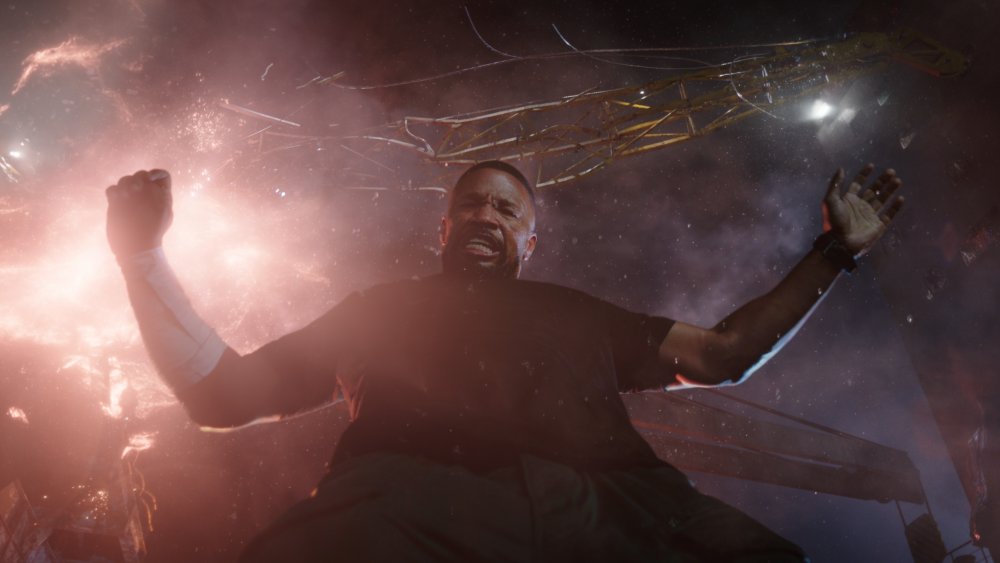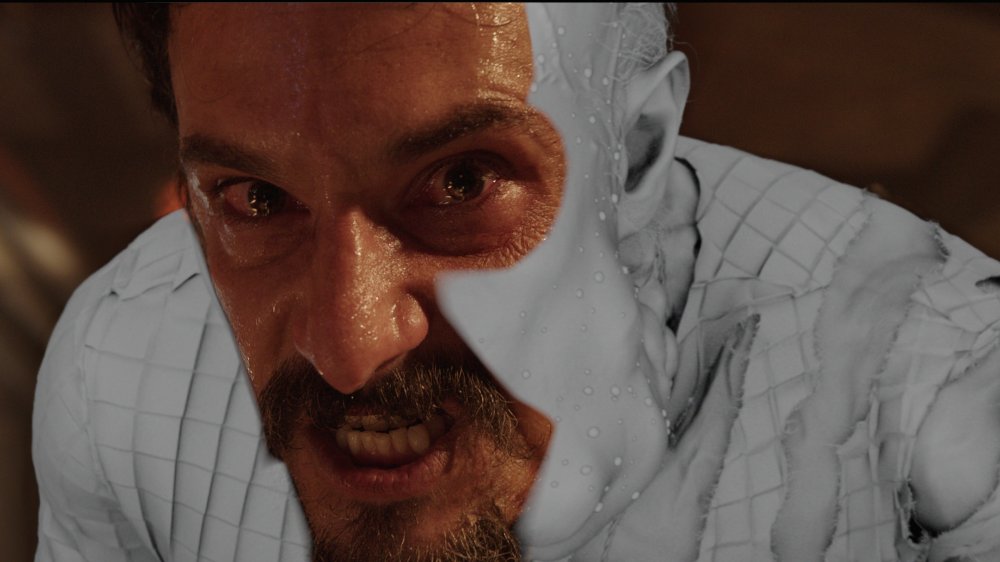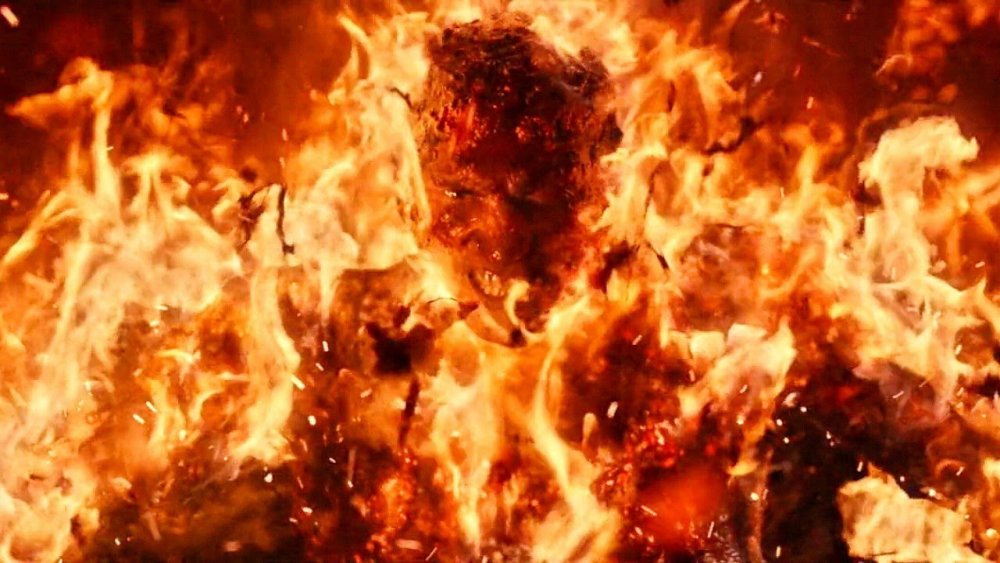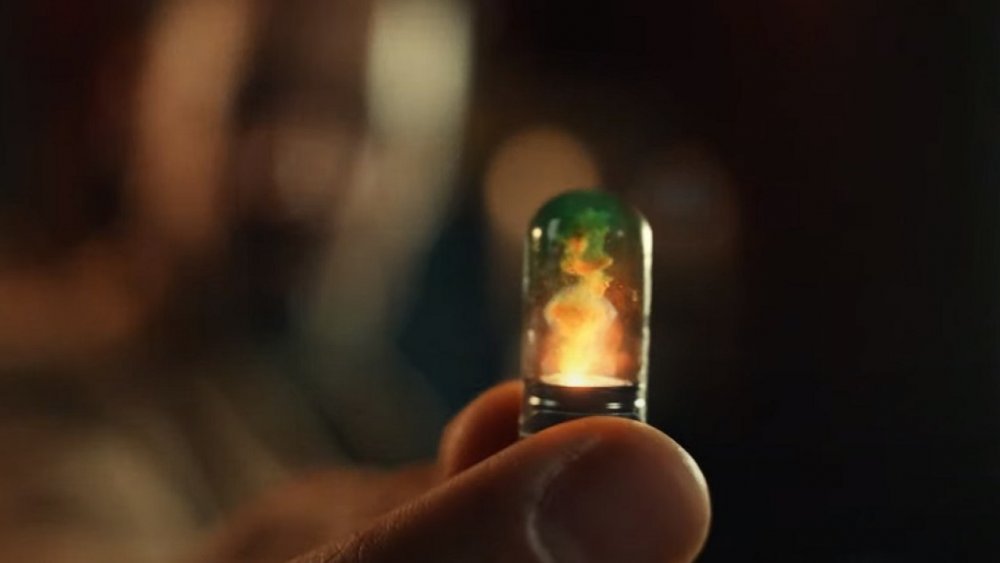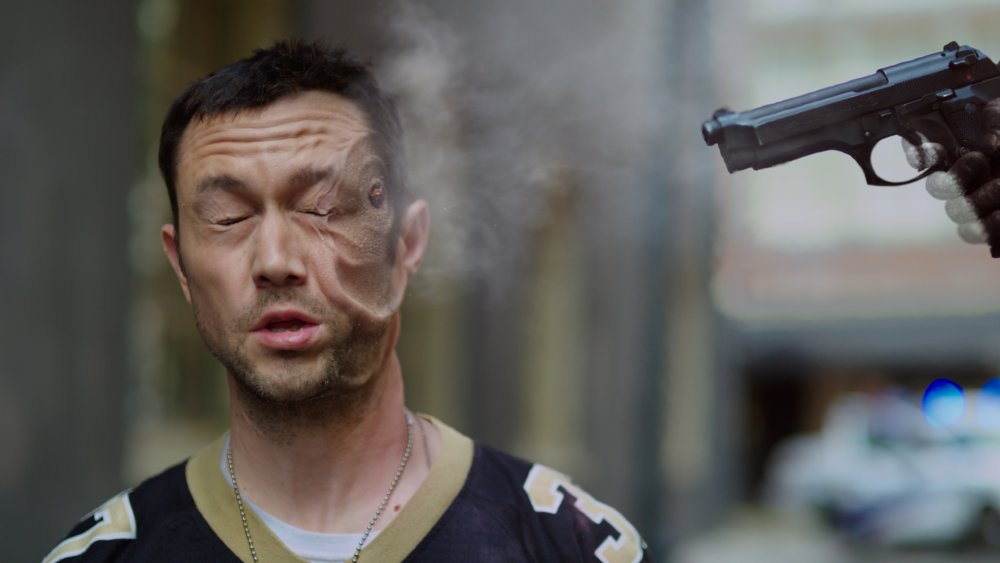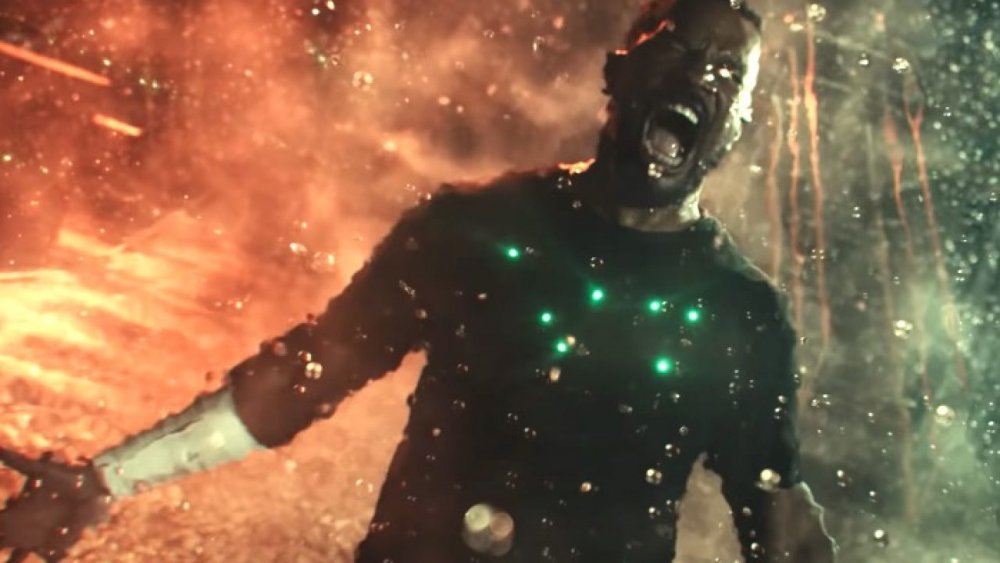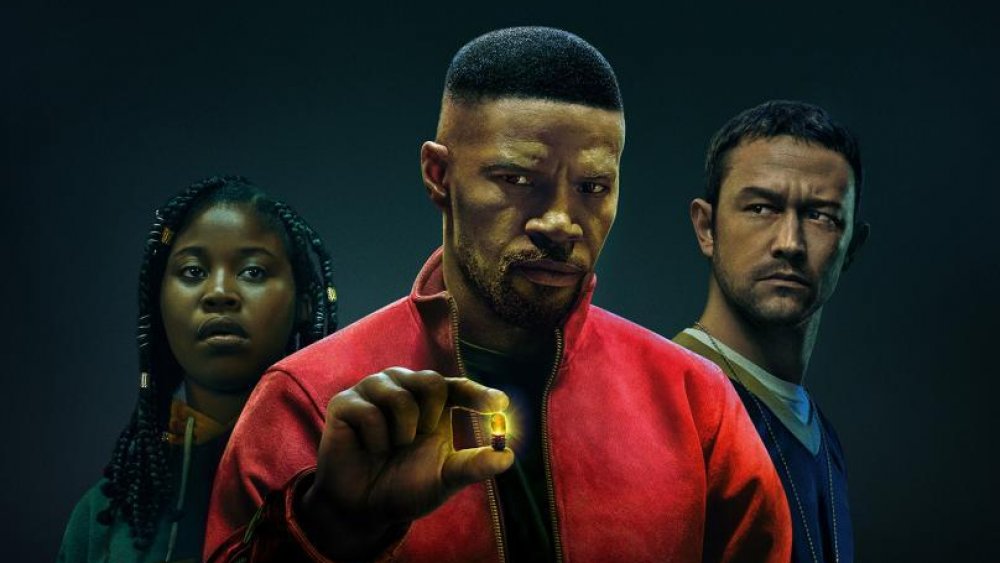Project Power Effects Supervisor Ivan Moran - Exclusive Interview
Netflix's Project Power had a particular challenge going into production: How to take cinematic superpowers, which have been a staple of our screens since Iron Man launched the Marvel Cinematic Universe, and make them not only impressive but distinctive. After all, the directors were trying to make a new sort of superhero story, one brought down to street level and set against the gritty backdrop of New Orleans. They had the cast, including big names like Jamie Foxx and Joseph Gordon-Levitt. They had the concept. They just needed the imagery.
Enter Ivan Moran. As Project Power's visual effects supervisor, he was tasked with taking the tried and true concept of superhuman abilities and giving it a fresh visual spin that would help the film stand out in a crowded field. Fortunately, Moran and his team hit on the idea of basing the movie's medically induced powers on the twin scientific pillars of physics and biology, resulting in a distinctive look and feel that gives Project Power its unique identity.
Looper sat down with Moran for a conversation about finding inspiration in the animal kingdom, turning Hollywood stars into superheroes, and why there's simply no substitute for practical effects.
Ivan Moran's Project Power creative process started early in production
We live in the golden age of superhero movies, and superpowers have been done all over the place. What was the design and VFX philosophy going into this movie in terms of how you wanted those things to be uniquely represented onscreen?
Well, I think that in very early meetings with the directors, what they really wanted was... I'm hesitant to call them superpowers, so let's say "abilities" that could actually be scientifically plausible. The way they described it was, "Abilities with consequences." Yes, in some cases, the abilities are positive, but they do have negative physiological effects on the body. Mattson Tomlin, the script writer, had this great idea that they should all be based somehow from the animal kingdom, to ground them. There are no magic powers, nothing's arbitrary like that. They riffed off ideas like "The Incredible Hulk is cool, but why isn't he naked? How do his shorts manage to stay on?"
So they really wanted to go for something that could actually be scientifically plausible. They approached me very early on to do the work and be the supervisor, and produce something pretty unique — something that could actually be plausible. I've got a bit of a physics background, so I love doing a little bit of nonsense pseudoscience to sort of back up projects whenever I'm designing stuff, if I can get the chance. So they actually asked me, "Hey, we've got two problems that we can't solve. One is, why does everyone get a different power? And the other is, what could actually be plausibly happening that could actually give you these abilities? Is it possible?"
They weren't necessarily going to expose it to the audience, but it was just so that, as filmmakers and as a team, we've all got it in our heads. So I brainstormed a little bit, and then late one night I woke up in one of those eureka moments, and I came up with the idea that at the heart of all of us is basically subatomic vibrations. The power pill, rather than actually giving you the power, which is a bit mysterious and strange... I thought it would make more sense if it was purely an amplifier. So the power pill itself amplifies those subatomic vibrations that are within all of us to such a great extent that they actually manifest themselves physically in various ways.
The other theory, which was riffing off the script writer's animal kingdom idea, was that we all plausibly have shared matter with the universe, including potentially with animals past and present. So the idea is that perhaps if we had remnant DNA within us... again, power being an amplifier, it could bring those innate animal abilities to fruition physically. Some of the powers are animal-based, and some of them are purely vibration-based, like Newt on fire, or Art's power at the end. But yeah, that was the main brief, is that we wanted it to be as real as possible. It informed the methodology that I chose to use on how to actually shoot it.
Ivan Moran's animal inspiration for Project Power's powers
So when you get a direction like that, does that kick off a whole process of research, specifically when it comes to the animal-based powers?
So, I was really fortunate. Visual effects usually gets involved much earlier nowadays than we used to in previous years, which is great, because it's really important that we're there in sort of the early design stages. But I was actually brought on before we had a production designer, which is even more unique. And so with my art department at Framestore, working with a very talented art director, Jonathan Opgenhaffen, we had this awesome creative dialogue where we would riff off each other and say, "How could somebody be invisible?" Well, they can't, that's not scientifically possible, but they could be camouflaged.
Oh, so look at the octopus, look at the cuttlefish. How does it actually work? How do they do that? We looked at biology. Each of the characters came with this enormous amount of reference, even the bulletproof skin on Frank. What kind of secret is there out there that could be based on the animal kingdom? So we researched sort of a backstory for each of the characters.
By then, Naomi Shohan, our production designer, was on board. Then it was this three-pronged creative team back and forth with the directors. We then started to actually do pretty pictures. We decided to sort of concept: What does the fire guy look like? Now, knowing how he's on fire, what's the logic behind how he's actually combusting?
Now we can design it with that in place. I think that's what makes it so real. I mean, A, because a lot of it is actually real, is practical, which was a choice that I made, and I think the correct one. But also, there is this backstory. I mean, we toyed with, could we tell the audience, and how do you do that? Is it the blackboard scene with the chemistry teacher going, "Blah, blah, blah"? No, that's a bit naff. So, what we tried to do was, through the transformations visually, if you pay attention, there is logic behind how each of these characters are believably or plausibly getting these powers.
Project Power's practical advantage
You mentioned the practical elements, and that was one of the things that jumped out watching the behind the scenes video that Netflix put out in which you talked about the scene with Machine Gun Kelly and the fire elements. It was striking how much practical work was actually involved in something at which someone could easily look and think, "Oh, everything's CGI." Why was the decision made to incorporate all the practical elements that you did?
After reading the script and after speaking to the directors, it was really clear that there's no fantastical universe here to sort of... I wouldn't say "hide behind," but to sort of stylistically make it a touch easier for yourself. There's no alien planet. There's no sort of universe that we're creating, that we actually have a little bit more freedom to hide in from a full CG perspective. Most of the movie is essentially a kidnapping thriller. It's set in New Orleans. It's real, it's gritty, it's at night, there's rain. So the directors were desperate to make everything feel so grounded that when you're watching it, it's almost like you're running along with the actors.
The camera style is very documentary. I find it a little easier to copy reality as a visual effects supervisor, rather than imagine it. If you've literally got a blank slate and you make 100% CG shots, which I've done many times, you can make them look great with your experience, but often you get into that uncanny valley territory, where it looks great but it just doesn't quite look real.
I worked on Dark Knight for Framestore back in the day as a compositor, with the Two-Face character, and what makes Two-Face so successful is that half of him is real and half of him is not. So that was my approach going forward. I don't want 100% CG, because I just think that's going to be really, really, really difficult to pull off with the same gritty visceral realism as the rest of this film, but it's also going to be budgetarily challenging. So I thought, "Let's go a bit old school. Let's try and shoot as much practically as we possibly can." We know that some things are not going to work. Some things won't happen the way you want them, but at least we'll have reference. So what that meant is that my visual effects team had a perfect reference of what it was that we were trying to achieve.
In the case of the guy on fire, there was always real fire somewhere on the set, and we repeated Machine Gun Kelly's performances with a real stuntman on fire, because it's not just what the fire looks like, but none of us can imagine how fire moves when a guy's running down a hallway, jumping through a hole and punching at the camera. When you get the computer to simulate that, again, it can throw something back at you that's great, but is it real? I don't know. Whereas we had real footage of a stuntman getting up off the chair, falling down a hole, and punching a camera, so when the simulation came back from the computer, you could sort of compare it and go, "Not quite." It actually flicks up and then down, not just down. That kind of detail is what makes it so real, because it's basically handcrafted from reality.
Looking back, it seems like we were in this era a while ago in which CGI was going to be everything. It feels like, in recent years, things have swung back in the other direction, where it's a lot more practical effects, or practical effects that are working in tandem with CGI.
I mean, that's my style anyway, but I think it's a couple of reasons. One is, I think the other heads of departments are more educated. They're more savvy now on visual effects. So we're much more integrated early on. We sit around the table and prep with all of the other departments, and we go, "Okay, the directors want this thing. So stunts, are you able to drive the car into the wall? No? Okay. Special effects, are you able to make a model of a car driving into a wall? Maybe. Visual effects, are we able to make a CG car crash into a wall? Sure. Okay. Which one is the best one? Which one is going to be the most efficient, and which one is going to look the best?" That was the dialogue we had each time, because quite often, ironically, what's hard for visual effects is often easier for another department and vice versa. It was quite complementary, we found.
The other thing that I find slightly annoying with visual effects, although that's my industry so you know I have to protect them, is I think there's just a slight overconfidence. There's a little bit the feeling that we can do anything, whereas actually some things are difficult. I think if you do things when you're not quite ready for them, when we don't quite have the technology nailed, you date yourself straight away. And audiences are so savvy now. It's such a shame that there's a lot of CG that's not great, and so a lot of comments you see from people when they see movies is the CGI was rubbish or the CGI was great, whereas they never say the production design was rubbish or the production design was great. So CGI's got this slight taint, I think, because it was a bit fast out of the gate. I think visual effects are great for some things, not so great for other things, and I think they should be used cleverly.
All things being equal, would you rather something be practical or digital?
It depends on what it is. I mean, I always get people to shoot practical. The other thing I find is particularly with this movie, if there's really a guy running around on fire or there's really a guy in a miniature set with a giant suit on, which is how we did Biggie, it changes the psychology of the actors and it changes the psychology of the crew, because everyone there can feel the energy. Everyone's on the ball, and I think it just manifests itself in a better product versus green screen.
Did you have a favorite power to work on or render in this film?
Oh, there are so many. They're all so great. I mean, the fire one I'm particularly proud of, obviously, because of my crazy LED suit invention, which people can check out on the YouTube featurette. People have asked me what was the hardest one to do from a creative standpoint, and I think it was Art's power at the end, mainly because it was so difficult to shoot. We've got Phantom cameras at 900 frames a second in real rain, in New Orleans, outside with mosquitoes. It was full-on, but obviously there's a large component of visual effects to it. If I closed my eyes, I could envisage the whole sequence. I could just see it before me, but nobody else could. So the whole crew, all of the actors, all of my visual effects crew, would quite often along the journey sort of turn to me and say, "Is this is going to be cool? Is this going to look good? Do we know what we're doing?" And I'm saying, "It's going to be great. It's going to be great."
Ivan Moran on turning Joseph-Gordon Levitt into a super hero
So for the two main characters, let's take a look at each of their powers individually. What was it like bringing Joseph Gordon-Levitt's character's powers to life?
What we did is, you will see through the transformations, there's a vignette of these sort of macro moments, if you will. One of them is the effect on the eyeball, which is something that the directors always had in the script and early storyboard. So, we built a full CG eye — well, various eyes, actually, that do various things.
We have great reference. You're probably familiar with Oobleck, I think is what they call it in North America, which is basically corn powder mixed with water, and it produces what's called a non-Newtonian fluid. Basically, it acts as a liquid when it's got no pressure, and then when you apply pressure, it acts as a solid. There's YouTube reference of people firing bullets into this stuff, and it can stop a bullet, it can stop a brick. It can stop anything. So we came up with the idea that perhaps inside his body, power has amplified his subatomic vibrations and they've coalesced into this non-Newtonian fluid, which is what takes the impact of the bullet.
Then on the outside, there's research and development for military armor that's basically a very high form of that Oobleck idea inside, but then this laboratory-made spiderweb stuck on the outside that actually stops the thing penetrating in the first place. So we came up with the idea, again, riffing off an armadillo or a rhinoceros, that power had changed the biology of his skin surface to act like a bit of armor plating. and the force is actually taken by what's inside him.
It was one of the hardest ones to visually show, because think of something that says strength on skin. What does that look like? We tried a lot of things that looked non-organic, but I think that the subtleness of the rhino, armadillo pattern that we ended up with is cool, because it looks like a real organic creature.
And then, the shoot for that was really fun. It was sort of the same problem that I had with not wanting to do 100% CG. If I don't do something to Joseph, it doesn't matter what I shoot; I'm going to have to throw it away and replace it with a full CG face. So it's going to be a full CG face. That's not trivial. So we tried all sorts of things, and at the end, it was really old school. It was an air nozzle hidden behind the barrel of the real gun that shoots air into him. It's obviously shot high-speed. That's what produces the wrinkles. So in real time, poor Joseph Gordon-Levitt is going "Ow! Ow!" The only thing that was a bit of a giveaway was that his hair blew upwards because of the air. So we had to do CG hair to disguise that a bit.
There had to be a limit on the number of takes you could shoot compressed air into your star's face.
It was more about his comfort factor. I mean, he's such an incredible star. He'll do anything, but yeah, there were moments when it happened so quickly and then with a Phantom camera, you've got to wait, you sort of download it, and then you can see the take. So he would do a take and then we're all waiting, waiting, and then you look at it and you say, "Oh, it's great, but Joseph, you're closing your eyes, you're anticipating. It's like a nanosecond, but it gives it away. We're going to have to do another one. Sorry." It took, I don't know, probably about half an hour of actual shooting, a lot of setup and messing around, but that's such an incredible shot.
Bringing Jamie Foxx's pistol shrimp-inspired power to life
So then, with Art's power, this is obviously the big payoff of the movie. We've been waiting to see what he can do. What was putting that together like?
We knew it had to be explosive as sort of the theater piece, if you will. We wanted it to be based from the animal kingdom, which is tricky — I mean, what kind of animal has explosive abilities? They also wanted it to be really unique. so how can we do an explosion that's really different? That's actually a bit tough, because we've seen millions of explosions in millions of movies that we all love.
So that's why we slowed it right down and did this two-minute ballet, if you will. I mean, slow motion is cool anyway, but we wanted to avoid, "Oh, here's the man with the energy blast." We spent this whole movie grounding everything, and then it's like he's got a ray gun inside him. What was that?
So what the pistol shrimp does is, it creates a shockwave, and the bubble that it creates, it basically turns the water into plasma.The center of the bubble is like the temperature of the sun. It's like 6,000, 7,000 degrees Kelvin. So again, we were still riffing off the same sort of pseudo-science that I had used for the other characters. The idea is that he takes the pill power amplifiers, and his subatomic vibrations are far greater than we've seen, because obviously he's the original source. What happens is, it becomes infrasonic waves, which are basically outside the range of human hearing, but very powerful. There's infrasonic technology used in the military with which they can floor trees in forests. It's those infrasonic waves that then basically turn the raindrops into plasma. They vaporize it, and then they ionize it, and that causes a chain reaction, and that's what the explosion is.
Obviously, a lot of that is CGI. How did you prep the cast and the production for this vision that, like you said, you could see in your head and you know what it looks like, but no one else does?
We basically broke it down into beats. We want to show that he's vibrating. We want to show that those vibrations are transmitting to the raindrops, if you will. We want to show that the raindrops are vaporizing. We want to show that the raindrops are ionizing, and we want to show that everything's been decimated. We took those main beats and we did a lot of concept drawings, a lot of storyboards, but how do we tell those stories?
It had to be like, "Okay, on this day, we're shooting that storyboard and that storyboard, and they're going to take four passes. We're going to shoot it at this speed, that speed." It's a mixture of speeds because high-speed camera work has a low light problem. It needs a lot of lights. So given that it was nighttime, that was really challenging. And then we did a lot of CG rain to sell the speed of it.
We also had the actors acting slightly in slow motion so it was very clear. We had storyboards up on the day, and we would take Jamie and Dominique and the rest of the cast through it. We would say, "This is the moment when this happens. It's going to be shot like this," because for them, a lot of the action, it would be a millisecond. Then, when it's drawn out, that gives us the action that we wanted. So it was an incredible amount of prep. It was incredibly challenging. I mean, the poor actors out in the rain all night, night after night, after night. The crew sodden. It was almost a bridge too far.
Ivan Moran on why Project Power's most subtle effects might be its most impressive
So obviously, that's a big, flashy moment. What's a more subtle VFX moment from this movie that you're particularly proud of, or something you might not think would grab the audience, but that's actually really challenging to do?
Well, there are about 400 power shots — the big-ticket items, if you will — but there are actually about 600 very invisible effects. The ship is mostly CG, which is really impressive, because actually you think, "CG ship, that can't be too hard!" But it's actually difficult to do ships with so much detail and rust and paint, and it's actually quite difficult to pull off. So I'm really proud of the ship. The ship's amazing, because we only had a ship for about two days of shooting. Most of the wide shots, it's all CG.
Most of the skies are replaced subtly, but to give it a little bit more jazz. New Orleans is one of those amazing places where pretty much all the time, there are these crazy cloud formations in the sky night and day. Of course, every single time we shot, it was just jet black. So we shot a lot of second unit reference of clouds, and put those in. Those details I think are really cool, because they just give it an extra element, but the audience would never know that something's been altered.
I mean, the whole car crash sequence I was particularly proud of, because we shot some of it on a process trailer, which is basically a car that's on a trailer. You can actually drive down a street; you don't have to do green screen. Then some of it, by necessity and safety, had to be green screen. So this is a mix of both methods, but you can't tell. So yeah: A lot of invisible effects, as I like to call them.
What's something that you would like fans and viewers to know about this type of work that might be a misperception about how it operates?
I've worked on very many different forms of effects, from big flashy effects to the sort of effects you would never know were effects. I personally prefer the latter. I love to assist the directors with their storytelling. I've done many movies where you wouldn't know there were any visual effects at all, and I think that's the thing that people don't realize. When people think of effects, they think of the giant octopus and they think of the superheroes and the planet exploding or whatever. Those flashy moments are awesome, but I think sometimes they're overdone. Sometimes they're there because people want them there, rather than, do they have to be there? Do they really tell the story?
I think audiences are much more savvy now. People are much more interested in behind the scenes and industry magazines, and I would love it if audiences could sort of admire the effects that they can't see, that they don't realize are there, because pretty much every movie now has hundreds and hundreds of shots of visual effects in many forms.
